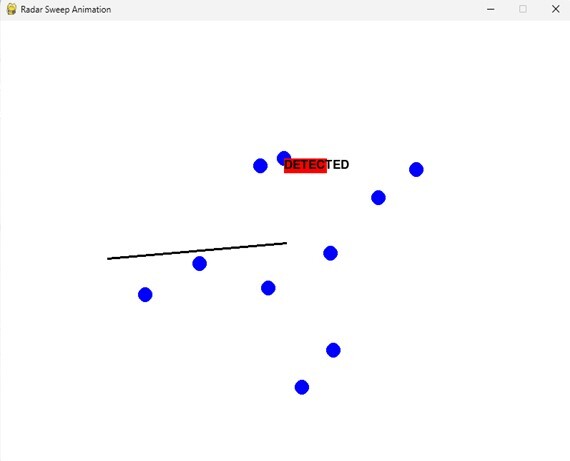
 Data Structure
Data Structure Networking
Networking RDBMS
RDBMS Operating System
Operating System Java
Java MS Excel
MS Excel iOS
iOS HTML
HTML CSS
CSS Android
Android Python
Python C Programming
C Programming C++
C++ C#
C# MongoDB
MongoDB MySQL
MySQL Javascript
Javascript PHP
PHPPhysics
Chemistry
Biology
Mathematics
English
Economics
Psychology
Social Studies
Fashion Studies
Legal Studies
- Selected Reading
- UPSC IAS Exams Notes
- Developer's Best Practices
- Questions and Answers
- Effective Resume Writing
- HR Interview Questions
- Computer Glossary
- Who is Who
Creating a radar sweep animation using Pygame in Python
Pygame is a cross-platform set of Python modules designed for writing video games. It includes computer graphics and sound libraries designed to be used with the Python programming language. Pygame is not a game development engine, but rather a set of tools and libraries that allow developers to create 2D games in Python.
Pygame provides a variety of functions and classes to help developers create games, including image loading and manipulation, sound playback and recording, keyboard and mouse input handling, sprite and group management, and collision detection. It also includes built-in support for common game development tasks such as animation, scrolling, and tile-based maps.
Pygame is open source and free to use, and it runs on Windows, macOS, Linux, and other platforms. It is often used in educational settings as an introduction to game development or as a tool for teaching programming concepts.
Components of a Radar Sweep Animation
A basic radar sweep animation consists of the following components −
Radar Circle − This is the circle that represents the range of the radar. It is centered at the origin and has a fixed radius.
Radar Sweep − This is a line that rotates around the center of the circle. It represents the beam emitting from the radar and sweeps across 360 degrees.
Radar Targets − These are the objects that we want to detect using the radar. They are represented as points on the screen.
Now that we know the components of a radar sweep animation, let's dive into the implementation using Pygame.
Prerequisites
Before we dive into the task few things should is expected to be installed onto your
system −
List of recommended settings −
pip install Numpy, pygame and Math
It is expected that the user will have access to any standalone IDE such as VSCode, PyCharm, Atom or Sublime text.
Even online Python compilers can also be used such as Kaggle.com, Google Cloud platform or any other will do.
Updated version of Python. At the time of writing the article I have used 3.10.9 version.
Knowledge of the use of Jupyter notebook.
Knowledge and application of virtual environment would be beneficial but not required.
It is also expected that the person will have a good understanding of statistics and mathematics.
Implementation Details
Importing Libraries − We will first import the necessary libraries - Pygame, NumPy and Math.
import pygame import math import random
Initializing the Game Window − We will initialize the game window with the required width and height using the Pygame library.
WIDTH = 800
HEIGHT = 600
pygame.init()
screen = pygame.display.set_mode((WIDTH, HEIGHT))
pygame.display.set_caption("Radar Sweep Animation")
clock = pygame.time.Clock()
Setting up the Game Environment − We will set up the game environment by defining the colors, background, and frame rate of the animation.
WHITE = (255, 255, 255) BLACK = (0, 0, 0) RED = (255, 0, 0) BLUE = (0, 0, 255)
Set the frame rate of the animation
Defining the Radar Circle − We will define the radar circle with the required radius and center coordinates. We will also set the color and line thickness of the circle.
radar_circle_radius = 200 radar_circle_center_x = int(WIDTH / 2) radar_circle_center_y = int(HEIGHT / 2)
Defining the Radar Sweep − We will define the radar sweep by setting the initial angle to zero degrees and incrementing it in each frame to make it sweep across 360 degrees. We will also set the color and thickness of the sweep line.
Define the radar sweep
radar_sweep_angle = 0 radar_sweep_length = radar_circle_radius + 50 def update(): # Increment the angle in each frame global radar_sweep_angle radar_sweep_angle += 1 # Draw the radar sweep line def draw_radar_sweep(): x = radar_circle_center_x + radar_sweep_length * math.sin(math.radians(radar_sweep_angle)) y = radar_circle_center_y + radar_sweep_length * math.cos(math.radians(radar_sweep_angle)) pygame.draw.line(screen, BLACK, (radar_circle_center_x, radar_circle_center_y), (x, y), 3)
Defining the Radar Targets − We will define the radar targets using random x and y coordinates within the range of the radar circle. We will also set the color and radius of the targets.
num_targets = 10
target_radius = 10
targets = []
for i in range(num_targets):
x = random.randint(radar_circle_center_x - radar_circle_radius,
radar_circle_center_x + radar_circle_radius)
y = random.randint(radar_circle_center_y - radar_circle_radius,
radar_circle_center_y + radar_circle_radius)
targets.append((x, y))
# Draw the radar targets
def draw_radar_targets():
for target in targets:
pygame.draw.circle(screen, BLUE, target, target_radius)
distance_to_target = math.sqrt((target[0] - x) ** 2 + (target[1] - y) ** 2)
if distance_to_target <= target_radius:
pygame.draw.rect(screen, RED, (target[0], target[1], 60, 20))
font = pygame.font.SysFont(None, 25)
text = font.render("DETECTED", True, BLACK)
screen.blit(text, (target[0], target[1]))
Running the Game − We will run the game by creating a pygame window, setting the necessary event handlers and running the game loop.
# Main game loop
running = True
while running:
for event in pygame.event.get():
if event.type == pygame.QUIT:
running = False
screen.fill(WHITE)
update()
draw_radar_sweep()
draw_radar_targets()
pygame.display.update()
clock.tick(FPS)
# Quit the game
pygame.quit()
Final Program, code
import pygame
import math
import random
# Initializing the Game Window:
WIDTH = 800
HEIGHT = 600
pygame.init()
screen = pygame.display.set_mode((WIDTH, HEIGHT))
pygame.display.set_caption("Radar Sweep Animation")
clock = pygame.time.Clock()
# Defining colors:
WHITE = (255, 255, 255)
BLACK = (0, 0, 0)
RED = (255, 0, 0)
BLUE = (0, 0, 255)
# Set the frame rate of the animation
FPS = 60
# Defining the Radar Circle:
radar_circle_radius = 200
radar_circle_center_x = int(WIDTH / 2)
radar_circle_center_y = int(HEIGHT / 2)
# Define the radar sweep
radar_sweep_angle = 0
radar_sweep_length = radar_circle_radius + 50
# Define the radar targets
num_targets = 10
target_radius = 10
targets = []
for i in range(num_targets):
x = random.randint(radar_circle_center_x - radar_circle_radius,
radar_circle_center_x + radar_circle_radius)
y = random.randint(radar_circle_center_y - radar_circle_radius,
radar_circle_center_y + radar_circle_radius)
targets.append((x, y))
def update():
# Increment the angle in each frame
global radar_sweep_angle
radar_sweep_angle += 1
# Draw the radar sweep line
def draw_radar_sweep():
x = radar_circle_center_x + radar_sweep_length *
math.sin(math.radians(radar_sweep_angle))
y = radar_circle_center_y + radar_sweep_length *
math.cos(math.radians(radar_sweep_angle))
pygame.draw.line(screen, BLACK, (radar_circle_center_x,
radar_circle_center_y), (x, y), 3)
# Draw the radar targets
def draw_radar_targets():
for target in targets:
pygame.draw.circle(screen, BLUE, target, target_radius)
distance_to_target = math.sqrt((target[0] - x) ** 2 + (target[1] - y)** 2)
if distance_to_target <= target_radius:
pygame.draw.rect(screen, RED, (target[0], target[1], 60, 20))
font = pygame.font.SysFont(None, 25)
text = font.render("DETECTED", True, BLACK)
screen.blit(text, (target[0], target[1]))
# Main game loop
running = True
while running:
for event in pygame.event.get():
if event.type == pygame.QUIT:
running = False
screen.fill(WHITE)
update()
draw_radar_sweep()
draw_radar_targets()
pygame.display.update()
clock.tick(FPS)
# Quit the game
pygame.quit()

We can see the output of the program where the animation of the game can be observed.
Conclusion
In this document, we explored how to create a radar sweep animation using Pygame in Python. We learned about the components of a radar sweep animation and walked through the implementation details using code snippets and real-world examples. Pygame provides a user-friendly API for game development and is a great choice for creating 2D video games and animations. With the knowledge gained from this document, you should now be able to create your own radar sweep animations using Pygame.

